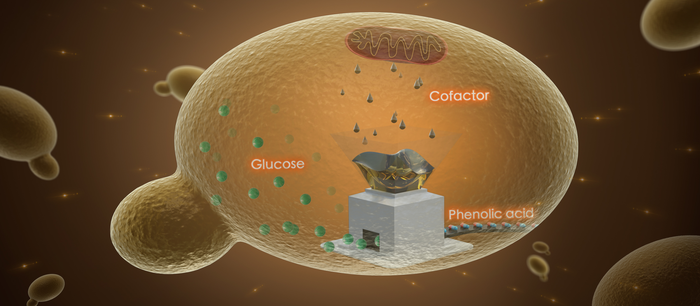In the past decade, advances in synthetic biology paved the way toward the sustainable synthesis of complex natural products.

Credit: DICP
In the past decade, advances in synthetic biology paved the way toward the sustainable synthesis of complex natural products.
The baking yeast Saccharomyces cerevisiae has been widely used in food industry and has become one of the main platforms for building cell factories due to its robustness, convenient cellular engineering, and reliable safety.
Recently, a research group led by Prof. ZHOU Yongjin from the Dalian Institute of Chemical Physics (DICP) of the Chinese Academy of Sciences (CAS), in collaboration with Prof. ZHANG Lei from Naval Medical University, has developed efficient cofactor engineering strategies to derive phenolic acid biosynthesis in yeast.
This study was published in Nature Chemical Biology on April 28.
The cofactor metabolism is tightly regulated and complicatedly distributed in sub-organelles in eukaryotic cell such as yeast. Thus, it requires novel and feasible engineering strategies to cope with the complex cofactor regulation.
The researchers developed tailored engineering strategies to enhance the supply, re-localization, and recycling of cofactors NADPH, FAD(H2), and SAM, which enabled high-level production of caffeic acid (5.5 g/L) and ferulic acid (3.8 g/L).
“This work reveals the regulation of different cofactors in yeast, especially the distribution of cofactors between different organelles in cells, and provides theoretical guidance for cofactor engineering,” said Prof. ZHOU. “It also provides sufficient precursors for the efficient synthesis of complex active natural products.”
The study was supported by the National Key Research and Development Program of China, the National Natural Science Foundation of China, the Liaoning Revitalization Talents Program, and the Innovation Grant from DICP.
Journal
Nature Chemical Biology
DOI
10.1038/s41589-022-01014-6
Method of Research
Commentary/editorial
Subject of Research
Not applicable
Article Title
Engineering cofactor supply and recycling to drive phenolic acid biosynthesis in yeast




